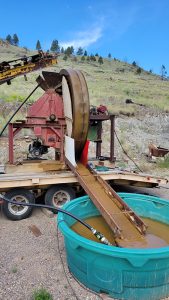Gold Ore Mill
 The mining industry has long been propelled by the allure and value of gold. To extract this precious metal from its naturally occurring state, a series of processes are employed, one of which is gold ore milling. The gold ore mill, often referred to as a mill or a stamp mill, is an integral part of the mining operation that employs mechanical methods to grind and crush the extracted ore into smaller pieces for further processing.
The mining industry has long been propelled by the allure and value of gold. To extract this precious metal from its naturally occurring state, a series of processes are employed, one of which is gold ore milling. The gold ore mill, often referred to as a mill or a stamp mill, is an integral part of the mining operation that employs mechanical methods to grind and crush the extracted ore into smaller pieces for further processing.
Definition and Overview of Gold Ore Mill
A gold ore mill is a facility where the raw mined gold-bearing ore is crushed into fine particles through various mechanical means. These particles are then further processed to extract the valuable metal within them. Gold ore mills have evolved over time to improve efficiency and increase recovery rates.
Traditionally, gold ore milling was accomplished through manual labor-intensive methods such as panning and sluicing. Miners would manually separate the heavier gold particles from gravel or sand by swirling water in a shallow pan or passing it through riffles in a sluice box.
While these techniques were effective to some extent, they were limited in terms of processing large quantities of ore efficiently. In the 19th century, stamp mills revolutionized gold extraction by introducing mechanization into the process.
Stamp mills utilized heavy iron stamps that pounded down on massive rock crushers to pulverize the raw material into finer particles. This innovation significantly increased productivity while reducing manual labor requirements.
Importance of Gold Ore Milling in the Mining Industry
 Gold ore milling plays a crucial role in modern mining operations due to several reasons: 1) Enhanced Extraction Efficiency: The primary objective of gold ore milling is to liberate fine particles of gold from other minerals present in the raw material. By reducing particle size through crushing and grinding processes, miners expose larger surface areas for chemical reactions involved in later extraction steps.
Gold ore milling plays a crucial role in modern mining operations due to several reasons: 1) Enhanced Extraction Efficiency: The primary objective of gold ore milling is to liberate fine particles of gold from other minerals present in the raw material. By reducing particle size through crushing and grinding processes, miners expose larger surface areas for chemical reactions involved in later extraction steps.
2) Increased Recovery Rates: Efficiently extracting gold from ore is not only about breaking down the rock but also optimizing the subsequent recovery processes. Milled ore facilitates effective gold extraction techniques such as cyanidation and flotation, leading to higher recovery rates and improved overall profitability.
3) Economic Viability: Gold ore milling is an economically viable process that enables mining companies to extract valuable gold particles from low-grade or complex deposits. By employing cost-effective milling techniques, miners can make previously unprofitable projects financially feasible.
4) Technological Advancements: The continuous advancement of milling technologies has led to significant improvements in efficiency, safety, and environmental impact within the mining industry. The evolution of gold ore mills has enabled miners to optimize their operations by adopting state-of-the-art equipment and processes.
Gold ore milling is an integral part of the mining industry that plays a vital role in extracting precious metals efficiently and profitably. Understanding the definition, historical background, and importance of gold ore mills provides a foundational knowledge base for exploring subsequent sections that delve into the intricate details of this critical process.
Historical Background
Early Methods of Gold Extraction and Processing
Gold has captivated human fascination for centuries, and the quest to extract this precious metal from its natural state dates back to ancient times. Early civilizations developed various techniques to recover gold from its ores. The most rudimentary methods involved simple processes such as panning and sluicing.
Panning Techniques
Panning is a technique that relies on the density difference between gold and other sediments in order to separate them. Miners would scoop up sediment-rich material from riverbeds or stream banks and place it in a shallow pan filled with water.
By swirling the pan carefully, the lighter materials would be washed away while the denser gold particles would settle at the bottom due to their weight. This manual process required patience, skill, and keen observation to identify specks of gold glimmering among the sediment.
Sluicing Techniques
Sluicing was another common method used by early miners for extracting gold. It involved constructing wooden troughs or channels called sluices that were placed in flowing watercourses such as rivers or streams.
Miners would shovel raw material into the top end of a sluice box while simultaneously rinsing it with water. The flowing water carried away lighter materials while heavier particles, including gold nuggets and flakes, became trapped in strategically placed riffles along the bottom of the sluice box.
Introduction of Stamp Mills in the 19th Century
Although techniques like panning and sluicing were effective in recovering small amounts of gold, they were limited by labor requirements and scalability. The advent of stamp mills revolutionized gold ore processing during the 19th century.
The Purpose & Operation of Stamp Mills
Stamp mills employed heavy iron stamps mounted on a rotating shaft to crush vast quantities of ore. The crushed rock was then further processed to extract the gold.
These stamp mills were usually powered by water, steam engines, or even animal labor. The primary advantage of stamp mills was their ability to process large quantities of ore efficiently and swiftly, making them ideal for industrial-scale gold mining operations.
Impact on Gold Mining
The introduction of stamp mills marked a turning point in the history of gold mining. It enabled miners to target larger deposits that were not feasible with traditional methods.
This advancement in technology led to a significant increase in gold production and transformed the mining industry into a more organized and profitable endeavor. By incorporating these innovative methods into their operations, early miners laid the foundation for future advancements in gold ore milling processes, which eventually paved the way for modern extraction techniques we employ today.
Gold Ore Milling Process
 Crushing and Grinding Stage
Crushing and Grinding Stage
The gold ore milling process begins with the crushing and grinding stage, where the extracted ore is prepared for further processing. This crucial step involves breaking down the large rocks into smaller pieces, allowing for easier extraction of gold particles. Various types of crushers are used in this stage, each designed to handle specific types of ores and achieve desired particle sizes.
Primary crushers: Jaw crushers, Gyratory crushers, Impact crushers
Primary crushers play a vital role in reducing the size of gold-bearing rocks to a manageable level. Jaw crushers are commonly used due to their simplicity and high capacity to handle large feed sizes efficiently.
Gyratory crushers offer similar advantages but are typically employed for larger-scale operations. Impact crushers, on the other hand, utilize impact forces to break down the ore by striking it against rigid surfaces or hammers.
Secondary crushers: Cone crushers, Roll crushers, Hammer mills
Once the primary crushing has been completed, secondary crushers further reduce the size of crushed ore particles. Cone crushers are widely utilized in this stage as they provide excellent reduction ratios and precise product sizing.
Roll crushers apply compression forces between two rotating rollers to break down materials effectively. Hammer mills use rotating hammers within a chamber to shatter rocks into smaller fragments rapidly.
Ore Classification and Size Reduction
After undergoing initial crushing and grinding stages, gold-bearing ores go through classification and size reduction processes to optimize subsequent recovery methods.
Screening and Sorting Techniques: Trommels, Vibrating Screens, Hydro cyclones
Screening techniques involve passing crushed ore through various types of screens that filter out particles based on their size or shape. Trommels consist of cylindrical drum-like screens that rotate while water is added to assist separation by size. Vibrating screens use high-frequency vibrations to separate particles, and hydro cyclones utilize centrifugal force to separate solids from liquids.
Size Reduction Methods: Crushing, Grinding, Milling Circuits
To achieve the desired particle size for efficient gold extraction, further size reduction is often necessary. Size reduction methods include crushing, grinding, and milling circuits. Crushing involves applying mechanical forces to break down the ore into smaller fragments.
Grinding refers to the process of reducing particle sizes through abrasive forces, typically with the use of ball mills, rod mills, or SAG mills. Milling circuits combine various stages of crushing and grinding to create finely ground ore suitable for subsequent processing.
Cyanidation Process for Gold Extraction
The cyanidation process is a widely used method for extracting gold from its ores due to its effectiveness and economic feasibility.
Introduction to Cyanide Leaching
Cyanide leaching involves the use of a weak cyanide solution that dissolves gold from crushed ore particles. The cyanide forms complexes with gold ions in a chemical reaction called dissolution. This process relies on the high affinity between cyanide and gold ions but must be carefully regulated due to its toxicity.
Role of Oxygen in the Leaching Process
Oxygen plays a crucial role in enhancing the efficiency of cyanide leaching by accelerating the dissolution kinetics of gold particles. It promotes oxidation reactions that facilitate the breakdown of complex compounds and enable better accessibility of gold during leaching.
Carbon-in-Pulp (CIP) and Carbon-in-Leach (CIL) Processes
The CIP and CIL processes are widely used methods for recovering gold from cyanide leach solutions. In both processes, activated carbon is used as an adsorbent material to selectively capture dissolved gold ions onto its surface. The loaded carbon is then separated and the gold is subsequently eluted, resulting in a purified gold solution ready for further refining.
The CIP process involves leaching and adsorption of gold simultaneously, while the CIL process separates these two steps into distinct stages for improved efficiency. By comprehensively understanding the gold ore milling process, including crushing and grinding stages, ore classification and size reduction techniques, as well as the cyanidation process for gold extraction, we can appreciate the complexity involved in transforming raw ore into valuable gold concentrates.
Gold Recovery Techniques
Gold recovery techniques play a crucial role in extracting gold from ore, ensuring optimal yield and purity. Several methods are employed in the industry, including gravity separation, flotation, and other advanced processes. In this section, we will delve into the various gold recovery techniques employed by modern mills.
Gravity Separation Methods
Gravity separation is an age-old technique used to separate valuable minerals from gangue materials based on their specific weight differences. Within the realm of gold ore milling, three common gravity separation methods prevail: jigging, spiral concentrators, and shaking tables. Jigging involves the use of pulsating water to stratify particles according to their density.
The principle behind jigging is that denser particles settle faster than lighter ones when subjected to pulsating water flow. By adjusting the frequency and amplitude of pulsations, jigs can effectively separate gold-bearing particles from waste rock or other minerals.
Spiral concentrators utilize centrifugal force and gravity to separate minerals based on their particle size and shape. These devices consist of a helical trough that spirals downward along its axis while water is added to create a slurry.
As the slurry flows through the spiral concentrator, heavier particles settle towards the inner edge due to centrifugal force while lighter particles are carried outward. This mechanism allows for efficient separation of heavy mineral fractions containing gold.
Shaking tables are another widely employed gravity separation method in gold ore milling operations. They consist of a slightly inclined deck with riffles or grooves running across it horizontally.
The table is shaken rhythmically in a back-and-forth motion using mechanical or hydraulic means, creating an inclination along with a transverse flow of water. This flowing water helps separate valuable mineral grains from gangue materials based on their density differences.
Flotation Process
The flotation process is a widely used technique for gold recovery that relies on the selective attachment of air bubbles to hydrophobic particles, allowing for their separation from hydrophilic minerals. Flotation begins with the introduction of finely ground ore into a flotation cell, where various reagents are added to create conditions favorable for attaching air bubbles to valuable mineral particles. The primary objective of flotation is to promote the separation of gold-bearing sulfide minerals from other non-valuable minerals.
It is achieved through a complex series of physical and chemical reactions known as the froth flotation mechanism. In this process, air bubbles generated by agitation carry hydrophobic particles (gold-bearing sulfides) to the surface as froth, while water-loving gangue materials sink.
Types of flotation cells vary depending on factors such as cell design, size, and application. Common types include mechanical cells equipped with impellers that agitate the pulp and induce bubble-particle attachment.
Dissolved air flotation (DAF) cells use dissolved air in water under pressure to generate fine bubbles for particle separation. Column flotation cells offer advantages in terms of improved selectivity and reduced energy consumption.
Other Advanced Recovery Methods
In addition to gravity separation and flotation techniques, modern mills employ several advanced recovery methods to extract gold efficiently from ore. These methods include cyanide destruction processes, resin-in-pulp (RIP) technology, and bacterial oxidation for refractory ores.
Cyanide destruction processes focus on reducing or eliminating free cyanide present in tailings or solution streams after gold extraction. Various chemical treatments can be employed to convert cyanide into less toxic compounds or recover it for reuse in the milling process.
Resin-in-pulp (RIP) technology involves adsorbing gold onto porous resin beads within pulp, which are then separated and stripped of gold using elution. This method offers advantages in terms of higher gold recovery rates and reduced carbon footprints compared to traditional carbon-in-pulp (CIP) or carbon-in-leach (CIL) processes.
Bacterial oxidation is a specialized process employed for refractory ores that contain sulfide minerals impeding conventional extraction methods. Certain bacteria, such as Acid thiobacillus ferroxidase, can be used to oxidize sulfide minerals, making gold accessible for subsequent extraction through conventional milling techniques.
Mill Design
The design of a gold ore mill plays a crucial role in ensuring efficient processing and maximum gold recovery. Several key factors need to be considered when designing a mill:
1. Mill Size and Capacity:
The size and capacity of the mill depend on various factors, including the ore deposit characteristics, desired throughput, and economic considerations. The mill should be sized adequately to handle the expected feed rate and accommodate future expansion. A larger mill with higher capacity can improve overall efficiency by reducing the number of grinding stages required.
2. Grinding Circuit Configuration:
The choice of grinding circuit configuration is critical for optimizing gold recovery. Common configurations include single-stage AG/SAG mills followed by ball mills or two-stage AG/SAG mills followed by a ball mill circuit. The selection depends on factors such as hardness of the ore, desired grind size, and energy requirements.
3. Equipment Selection:
Selecting the appropriate equipment for each stage of the milling process is essential for achieving optimal performance. The choice of crushers, grinding mills, classifiers, and other equipment should be based on factors such as particle size distribution analysis, mineralogy, and operating conditions.
Conclusion
Gold ore milling is an indispensable process in the mining industry that enables efficient extraction of precious metal from ore deposits. Through historical advancements in techniques and equipment used in gold ore milling processes like crushing, grinding, classification, cyanidation, flotation, gravity separation methods, and more recently developed technologies like bacterial oxidation for refractory ores or resin-in-pulp technology; significant improvements have been made in terms of efficiency and environmental sustainability.
Gold mining and ore milling have come a long way, with continuous advancements aimed at maximizing gold recovery while minimizing the ecological impact. The design of modern gold ore mills integrates various technologies and considerations, such as size and capacity optimization, grinding circuit configuration, and equipment selection.
By implementing efficient processes and state-of-the-art technologies, the mining industry can ensure the sustainable extraction of gold from ore deposits for years to come. Ultimately, gold ore milling is not only a productive economic activity but also a testament to human ingenuity in harnessing nature’s resources.
As technology continues to evolve, we can look forward to even more innovative solutions that address the challenges of mining while preserving our planet’s precious ecosystems. By striking a balance between economic development and environmental stewardship, we pave the way for a future where responsible mining practices coexist harmoniously with nature.
Click here to read more on our Stutenroth Impact Mill page
